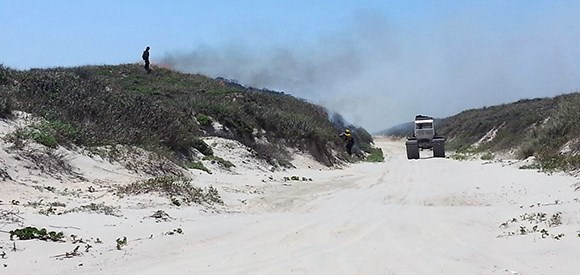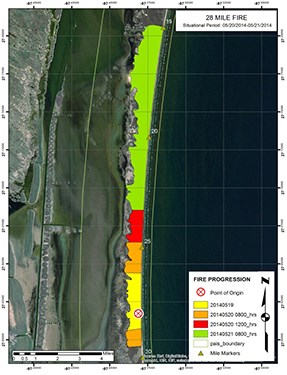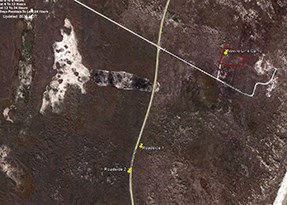Last updated: January 9, 2017
Article
Frequent Fuel Treatments Key to Fire Suppression Response at Padre Island

The fast-growing coastal prairie grasses and frequent lightning storms at Padre Island National Seashore support a very short fire return interval. Recent wildfires, including the 28 Mile fire and the Roadside 1 and 2 fires, demonstrate that fuels treatments and wildfire at Padre Island NS reduce fire spread and intensity in the area for 1-2 years. But the effectiveness does not last when that time frame is exceeded.

The 28 Mile fire was reported at Mile Marker 28 at approximately 9:30 pm on May 17, 2014. (View a larger version of the map pictured.) It was located approximately 40 miles south of Corpus Christi, Texas. It is believed to have been started by lightning on May 13, but infrequent traffic in the park’s backcountry area and poor visibility delayed detection.
Park staff flew over the 28 Mile fire and mapped it at 341 acres on the afternoon of May 18. Fire staff and resources from Big Thicket National Preserve and the U.S. Fish and Wildlife Service arrived on May 18 to assist in suppression efforts. Ten personnel were assigned to the incident. Resources included two utility terrain vehicles (UTVs), a Marsh Master—an amphibious fire vehicle used to fight fires in areas not accessible to fire engines—and miscellaneous overhead.

View a larger version of the Roadside 1 and 2 fire location map pictured.
Objectives included providing for public and firefighter safety, protecting the park’s sea turtle patrol cabin to the south, and oil and gas infrastructure to the north. In addition, firefighters protected the Green Hill Line Camp--remnants of the historic Dunn cattle ranch, consisting of a few fence posts and a loading chute for cattle. Fire managers also worked to minimize smoke duration and complete operations before the influx of visitors over Memorial Day weekend.
Fire managers implemented an indirect attack strategy due to fire behavior and hazards associated with direct attack in continuous fuels, including a lack of escape routes and safety zones. This strategy also increased the effective use of available resources.
Firefighters began initial attack on the southern end of the fire to protect the sea turtle patrol cabin, establishing a fireline a half-mile south of the fire edge. They began firing operations to burn out fuels between the fireline and the main body of the fire to secure the area at approximately 4:00 pm on May 19, increasing the fire size to 700 acres.
Firefighters also established a containment line north of the fire at the Yarborough Pass Road and began burnout operations at approximately 11:00 am on May 20, increasing the fire size to 1,250 acres. Ignition operations were completed on May 20 at approximately 5:00 pm. The final size of the fire was 5,933 acres, stretching from Mile Marker 15 to Mile Marker 29. The fire was contained later that evening at 6:00 pm, controlled the following day, and declared out on May 26.
The Roadside 1 and 2 fires that occurred in the park on May 30, 2014, also helped demonstrate the difference in the effectiveness of treatments. The Roadside 1 fire occurred six years after treatment of the same area during the 2008 Headquarters prescribed burn. No reduced fire behavior was observed on the Roadside 1 fire. In contrast, fire behavior on the Roadside 2 fire was reduced and resistance to control was minimized due to fuel reduction following 6 Mile fire, which burned in the same area in 2012.
Large, intense, fast-moving fires will continue to be a frequent occurrence at Padre Island National Seashore. This emphasizes the need for frequent fuel treatments, every one to two years, to enable fire managers to provide for firefighter and public safety, as well as protection for oil/gas infrastructure, park infrastructure, and sensitive natural and cultural resources.
The National Park Service is committed to safety, science, and stewardship. Park managers strive to ensure that the most current science-based information is integrated into fire and land management goals, decisions, and practices. This recent fuels treatment effectiveness information will be incorporated in updates to the park’s fire management plan.
Contact: Fulton Jeansonne, fire management officer
Email: Fulton_Jeansonne@nps.gov
Phone: (409) 951-6850
